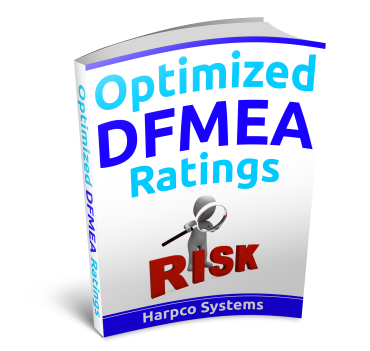Note: This article originally appeared in Quality Magazine under the title “Quality 101: Demystifying Design FMEAs”
Optimized Method For Establishing Design FMEA Ratings Part III
by Richard Harpster, President of Harpco Systems
Summary:
In Part I, the proper methods for determining Severity Ratings was covered. In Part II, Occurrence Ratings were explained. In Part III Detection Ratings and the limitations of RPN and SxO numbers are demonstrated.
Establishing the Design FMEA Detection Rating
The third rating that must be determined is the detection rating. The detection rating is used to define the effectiveness of the Design Controls in assessing the probability that the failure mode will occur due to the failure cause that it is linked to. A typical detection rating table found in most FMEA manuals is as follows:
| Rating | Criteria: Likelihood of Detection by Design Control |
| 10 | No design control or no chance of detection. |
| 9 | Very remote chance of detection. |
| 8 | Remote chance of detection. |
| 7 | Very low chance of detection. |
| 6 | Low chance of detection. |
| 5 | Moderate chance of detection. |
| 4 | Moderately high chance of detection. |
| 3 | High chance of detection. |
| 2 | Very high chance of detection. |
| 1 | Almost certain detection. |
The highly subjective nature of this table makes it very difficult to achieve consistent application of the rating system when evaluating the effectiveness of design controls. Following is an alternative rating table that should improve the FMEA group’s ability to consistently rate the effectiveness of design controls.
| Rating | Design Control Correlation To Failure Mode | Controlling Characteristic Status | Contributing Characteristic Status | External Factors |
| 1 | Good | Set Worst Case | Set All Worst Case | Worst Case |
| 2 | Good | Set Worst Case | Know All | Worst Case |
| 3 | Good | Know | Set All Worst Case | Worst Case |
| 4 | Good | Know | Know All | Worst Case |
| 5 | Good | Set Worst Case | Don’t Know All | Worst Case |
| 6 | Good | Know | Don’t Know All | Worst Case |
| 7 | Good | Don’t Know | Set All Worst Case/Know/Don’t Know All | Worst Case |
| 8 | Good | Don’t Know | Set All Worst Case/Know/Don’t Know All | Not Worst Case |
| 9 | Poor | Set Worst Case/Know/Don’t Know | Set All Worst Case/Know All/Don’t Know All | Worst Case/Not Worst Case |
| 10 | No Design Control | N/A | N/A | N/A |
In order to use the rating table, two definitions must be understood. The first definition is the Controlling Characteristic. This is the characteristic specification that is on the line of the Design FMEA that the detection rating is being developed for. If we were developing the detection rating for the first row of our example, the Controlling Characteristic would be the component material thickness. The second definition is the Contributing Characteristics. These are the characteristic specifications that are on all the other lines where the design control being evaluated can be found. In our example, there would be one Contributing Characteristic and it would be component material type.
In the example provided, the ‘Road Durability Test’ has good correlation with the road impact resistance that is being evaluated and represents the worst case impacts that will be experienced during the life of the component. The tested component material thickness is known at the time of testing but is not at the minimum of the specification. All of the component material properties have not been measured. Using the alternative detection rating table, the detection rating of 6 is assigned to the material thickness line and the rating of 7 assigned to the material properties line.
When using the alternative rating table, it is not uncommon to assign ratings in the 5-8 range. Many of the vehicle level tests being required by the automotive companies today would fall within this category. It is not easy to develop excellent design controls.
Determining What to Work On In the Design FMEA
Now that the ratings have been developed, the FMEA group must now decide which lines of the Design FMEA, to work on. The approach recommended by most FMEA manuals is to calculate the Risk Priority Number (RPN=Severity x Occurrence x Detection) and to begin working on the highest RPNs first. Some companies have gone as far as establishing RPN limits for improvement action activity. A typical approach is to require recommended actions for all RPNs over 100 and suggest recommended actions for RPNs greater than 36 but less than 100.
Unfortunately, when this method is used there is a high probability that the wrong issues will be selected for action. The following table demonstrates why this happens.
| Severity | Occurrence | Detection | RPN | SxO |
| 9 | 2 | 2 | 36 | 18 |
| 2 | 9 | 2 | 36 | 18 |
The table provides the ratings from two lines of a Design FMEA. The first line indicates that although the probability is low, there is a likelihood of a failure that could result in injury. The table also shows that excellent design controls exist to confirm the prediction. The second line indicates that there is a high probability of a noise or appearance failure occurring that the customer will not find objectionable enough to return. Excellent design controls exist to confirm the second line prediction as well.
If one uses RPN to decide on what to work on, both of the lines will be given the same importance. It is also interesting to note, that in some companies no action would be required since the RPN falls below the action limit. Realizing the inherent weakness when using RPN to prioritize required actions, some companies have decided to only use the SxO calculation (Severity x Occurrence). Although the SxO prioritization method is more effective than the RPN method, the provided example shows it does not work all the time. A completely new method of prioritization is needed and that is the class column.
In our discussion of the severity rating table, we introduced three zones: Safety/Legal Zone, Return/No Buy Zone and Conditioned Response Zone. The Safety/Legal Zone is the most expensive zone for a company to have an issue in. When an issue occurs in this zone it must be worked on first. If the occurrence rating of 1 is given the meaning of failure is unlikely, the Safety/Legal Zone is defined as lines in the Design FMEA which have severity ratings of 9-10 and occurrence ratings of 2-10. The Return/No Buy Zone is the second most expensive place for a company to be in. Although companies would not like to have any issues that result in return or non-purchase of their product, there is some low level of return/no buy zone issues where it is more expensive to make these issues go away than to absorb the loss when they occur. Many companies use an occurrence rating of 4 to establish the limit. Since Conditioned Response Zone issues have no immediate financial impact on the company, they should never be worked on. Following is a Class Column Symbol Table constructed using the preceding rules. Different companies have different symbols used to designate the zones. The symbol is placed in the Class column of the Design FMEA.
Class Column Symbol Table (S/L: Safety Legal Zone, R/NB: Return/No Buy Zone)
| 10 | S/L | S/L | S/L | S/L | S/L | S/L | S/L | S/L | S/L | |
| 9 | S/L | S/L | S/L | S/L | S/L | S/L | S/L | S/L | S/L | |
| 8 | R/NB | R/NB | R/NB | R/NB | R/NB | R/NB | R/NB | |||
| 7 | R/NB | R/NB | R/NB | R/NB | R/NB | R/NB | R/NB | |||
| 6 | R/NB | R/NB | R/NB | R/NB | R/NB | R/NB | R/NB | |||
| 5 | R/NB | R/NB | R/NB | R/NB | R/NB | R/NB | R/NB | |||
| 4 | R/NB | R/NB | R/NB | R/NB | R/NB | R/NB | R/NB | |||
| 3 | ||||||||||
| 2 | ||||||||||
| 1 | ||||||||||
| Sev/Occ | 1 | 2 | 3 | 4 | 5 | 6 | 7 | 8 | 9 | 10 |
Sometimes, there will be more than one item in the same zone. When this occurs, lines with the high SxO within the zone should be worked on first. If the SxOs are the same, use the RPN calculation for prioritization.
Establishing DFMEA Ratings: Conclusion
Once the failure modes, failure causes and design controls in the Design FMEA, have been defined, an efficient methodology is required to accurately identify where company resources should be used to achieve the greatest payback in design improvement. If followed, the methodology provided in this paper will accomplish this task. In a future article, an optimized method for establishing Process FMEA ratings will be presented.
Want to save this whole article in your files?
Click the book and we’ll send it to your email:
Note:
In Part I of this paper DFMEA Severity Ratings are explained:
Establishing Design FMEA Ratings Part I
In Part I of this paper DFMEA Occurrence Ratings are discussed:
Establishing Design FMEA Ratings Part II
About The Author

Richard Harpster
Richard Harpster is president of Harpco Systems, which he founded in 1987. Harpco Systems specializes in providing software, training, and consulting for risked-based product lifecycle management (RBPLM®). During the past 30 years, Harpster has helped hundreds of companies implement improved risk-based design and manufacturing systems in a wide variety of industries. He is a recognized expert in the application of FMEAs and has invented several new concepts, including the linking of design FMEAs to process FMEAs in 1990, which became an automotive industry standard 18 years later. His latest inventions in the field of RBPLM® include Requirements Risk Assessment (RRA®), Usage Risk Assessment (URA™), Multiple Integrated Cause Analysis (MICA™) and Rapid Integrated Problem Solving (RIPS®). He has published several papers on the topic of RBPLM®.
“Harpco breaks down the barriers and corrects the pitfalls so companies can reap the full benefits of FMEA. Classroom training not only properly teaches FMEA, but participants actually build their business’s FMEA as they go and are often blown away by how much work got accomplished. Harpco Systems has become known as the Modern FMEA for a reason. Its structured, simplified and sustainable.”
“We used QPlus to achieve Q1 and ISO 16949 successfully at the Ford Motor Co. Monroe BAO Plant. The software promoted linked documentation that prevented issues at internal and external audits. Assured the quality documents at the operations production level had all relevant and concurrent information that was reviewed in the program files. QPlus allowed the program members to create a baseline “Hot End Exhaust” database that produced linked documentation from the DFMEA to the production visual aids the operators used to perform correctly.”
“Harpco’s training is first rate and helps develop new ways of thinking about the importance of creating proper specifications early. Separately, I’ve seen firsthand the effectiveness of using their approach in problem solving, helping to advance problems that had reached a stall using traditional methods.”
“We were very fortunate to work with Rich Harpster and his team as we improved our DFMEA process at Calsonic. There is no better teacher, coach, implementer than Rich when it comes to creating a knowledge base for engineers to use in creating part specs to assure that products meet the customer’s requirements. Rich teaches the basics, then he accelerates the FMEA process so that requirements and specs are related in a database that can be continually updated.”
“I would like to thank Harpco Systems for the help, advice and frankly the education in how to design, develop, source and manufacture new to world products.”







